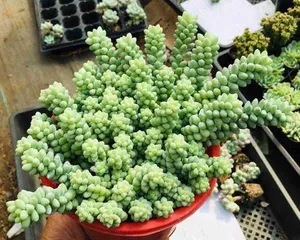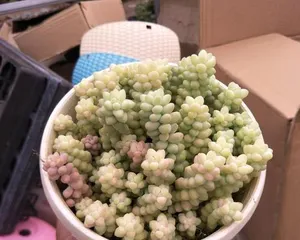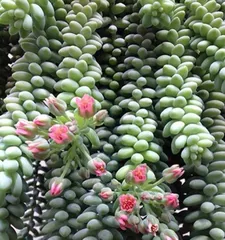The natural characteristics of succulents, such as their low water and fertilizer requirements and their tolerance for drought and heat, make them one of the most popular potted plants in cities. Rainbow Sedum, as an "internet celebrity" in the succulent world, is especially sought after. However, for beginners who have never grown succulents before, Rainbow Sedum is not always easy to care for. Below, I will introduce how to properly care for Rainbow Sedum succulents.

1. Understanding Rainbow Sedum Succulents
2. Selecting Rainbow Sedum Succulents
3. Well-draining and Aerated Soil
4. Sunlight and Exposure
5. Temperature and Humidity
6. Watering and Fertilizing
7. Pest and Disease Control
8. Pruning and Propagation
9. Daily Observation
10. Propagation Methods
11. Beautifying Rainbow Sedum Succulents
12. How to Display Rainbow Sedum Succulents
13. Suitable Companion Plants
14. Cultivation Experience for Rainbow Sedum Succulents
15. Things for Succulent Enthusiasts to Note
1. Understanding Rainbow Sedum Succulents
Rainbow Sedum succulents, also known as "Swiss Cream," belong to the Crassulaceae family. They are evergreen small shrubs native to South Africa. Their fleshy leaves have a soft, fuzzy texture and come in a rich variety of colors, such as red, pink, orange, yellow, and more.
2. Selecting Rainbow Sedum Succulents
When selecting a Rainbow Sedum, first check for any signs of pests, diseases, or wounds. Next, choose a plant with vibrant leaf colors, a neat shape, and sturdy stems. Finally, pay attention to the variety, as different types of Rainbow Sedum have slightly different growing requirements.

3. Well-draining and Aerated Soil
Rainbow Sedum requires well-draining and aerated soil; it is not suitable for regular potting soil. A mix of perlite, leaf mold, and sand is recommended.
4. Sunlight and Exposure
Rainbow Sedum loves a sunny environment, but intense sunlight can cause the leaves to change color, turn yellow, or even wither. Therefore, it is recommended to move the plant to a partially shaded spot during the intense afternoon sun to avoid excessive radiation.
5. Temperature and Humidity
Rainbow Sedum prefers a warm and dry environment, with an ideal growing temperature of 18°C to 28°C. During high summer temperatures, ensure good ventilation for cooling. In winter, avoid damp environments to prevent rot.

6. Watering and Fertilizing
Rainbow Sedum does not need frequent watering. When you do water, ensure it is thorough but not excessive. It's best to water after the topsoil has dried out. Fertilizing should also be done in moderation; a special succulent fertilizer can be applied once a month.
7. Pest and Disease Control
Rainbow Sedum is susceptible to pests and diseases like fungi and aphids. Therefore, it is important to regularly remove pests and weeds, and promptly dispose of infected leaves to prevent the spread of pathogens.
8. Pruning and Propagation
Pruning can encourage branching and control the size of the Rainbow Sedum. Propagation through cuttings is a common method for succulents, where one plant can be used to grow many new ones.
9. Daily Observation
The growth of Rainbow Sedum should be monitored regularly. If you notice any abnormalities like yellowing leaves, blackened leaf tips, or softening stems, take prompt action to prevent further damage.
10. Propagation Methods
The main propagation methods for Rainbow Sedum are stem cuttings and leaf cuttings. Stem cuttings are generally easier to succeed with, while leaf cuttings require careful attention to moisture retention.
11. Beautifying Rainbow Sedum Succulents
Rainbow Sedum is a very beautiful potted plant that can be enhanced with unique aesthetic effects through methods like bonsai design.
12. How to Display Rainbow Sedum Succulents
Rainbow Sedum is suitable for placing in well-ventilated areas, such as desks or windowsills. You can also enhance its beauty with decorative items like succulent stands.
13. Suitable Companion Plants
Rainbow Sedum can be paired with other succulents or with green plants to enhance the ornamental value of the entire space.
14. Cultivation Experience for Rainbow Sedum Succulents
Cultivating Rainbow Sedum requires long-term practice and experience accumulation. You can gain knowledge through various methods, such as communicating in forums or WeChat groups, or attending succulent care courses.
15. Things for Succulent Enthusiasts to Note
Growing Rainbow Sedum requires patience and attention to detail. It's also important to be mindful of specific care points, such as not overwatering and not keeping it in a dark, damp place for extended periods.
Caring for Rainbow Sedum does require some patience and attention, but as long as you follow the right methods, everyone can become a successful succulent enthusiast!